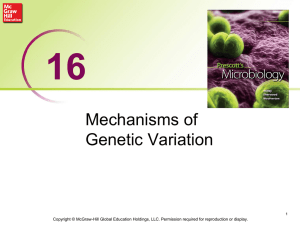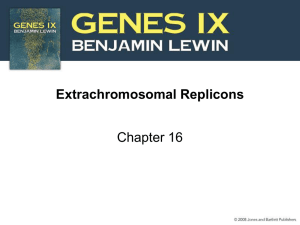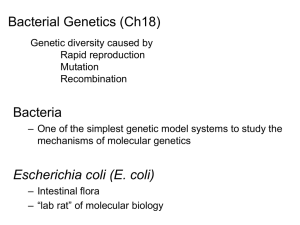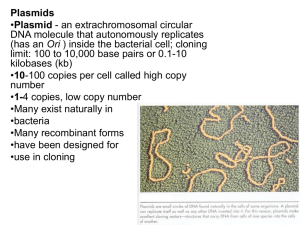BACTERIAL GENETICS Genetics is the study of genes including the
advertisement
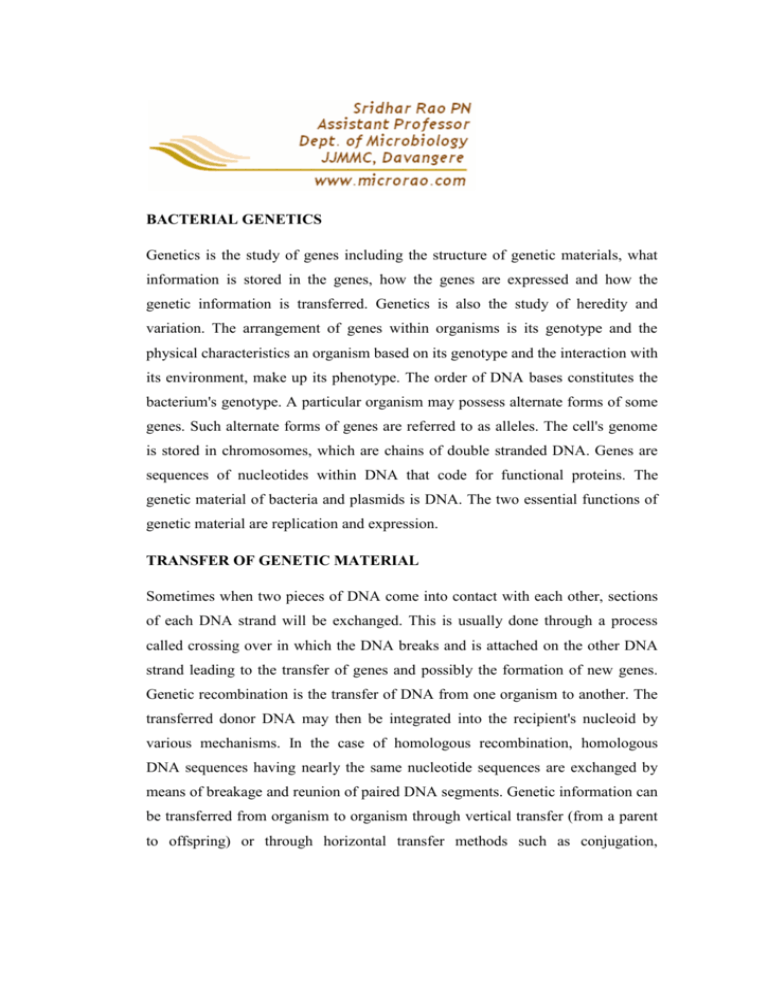
BACTERIAL GENETICS Genetics is the study of genes including the structure of genetic materials, what information is stored in the genes, how the genes are expressed and how the genetic information is transferred. Genetics is also the study of heredity and variation. The arrangement of genes within organisms is its genotype and the physical characteristics an organism based on its genotype and the interaction with its environment, make up its phenotype. The order of DNA bases constitutes the bacterium's genotype. A particular organism may possess alternate forms of some genes. Such alternate forms of genes are referred to as alleles. The cell's genome is stored in chromosomes, which are chains of double stranded DNA. Genes are sequences of nucleotides within DNA that code for functional proteins. The genetic material of bacteria and plasmids is DNA. The two essential functions of genetic material are replication and expression. TRANSFER OF GENETIC MATERIAL Sometimes when two pieces of DNA come into contact with each other, sections of each DNA strand will be exchanged. This is usually done through a process called crossing over in which the DNA breaks and is attached on the other DNA strand leading to the transfer of genes and possibly the formation of new genes. Genetic recombination is the transfer of DNA from one organism to another. The transferred donor DNA may then be integrated into the recipient's nucleoid by various mechanisms. In the case of homologous recombination, homologous DNA sequences having nearly the same nucleotide sequences are exchanged by means of breakage and reunion of paired DNA segments. Genetic information can be transferred from organism to organism through vertical transfer (from a parent to offspring) or through horizontal transfer methods such as conjugation, transformation or transduction. Bacterial genes are usually transferred to members of the same species but occasionally transfer to other species can also occur. TRANSFORMATION: Transformation involves the uptake of free or naked DNA released by donor by a recipient. It was the first example of genetic exchange in bacteria to have been discovered. This was first demonstrated in an experiment conducted by Griffith in 1928. The presence of a capsule around some strains of pneumococci gives the colonies a glistening, smooth (S) appearance while pneumococci lacking capsules have produce rough (R) colonies. Strains of pneumococci with a capsule (type I) are virulent and can kill a mouse whereas strains lacking it (type II) are harmless. Griffith found that mice died when they were injected with a mixture of live non capsulated (R, type II) strains and heat killed capsulated (S, type I) strains. Neither of these two when injected alone could kill the mice, only the mixture of two proved fatal. Live S strains with capsule were isolated from the blood of the animal suggesting that some factor from the dead S cells converted the R strains into S type. The factor that transformed the other strain was found to be DNA by Avery, McLeod and McCarty in 1944. Transformation is gene transfer resulting from the uptake by a recipient cell of naked DNA from a donor cell. Certain bacteria (e.g. Bacillus, Haemophilus, Neisseria, Pneumococcus) can take up DNA from the environment and the DNA that is taken up can be incorporated into the recipient's chromosome. Some bacteria are able to take up DNA naturally. However, these bacteria only take up DNA a particular time in their growth cycle (log phase) when they produce a specific protein called a competence factor. Uptake of DNA by Gram positive and Gram negative bacteria differs. In Gram positive bacteria the DNA is taken up as a single stranded molecule and the complementary strand is made in the recipient. In contrast, Gram negative bacteria take up double stranded DNA. CONJUGATION: In 1946 Joshua Lederberg and Tatum discovered that some bacteria can transfer genetic information to other bacteria through a process known as conjugation. Bacterial conjugation is the transfer of DNA from a living donor bacterium to a recipient bacterium. Plasmids are small autonomously replicating circular pieces of double-stranded circular DNA. Conjugation involves the transfer of plasmids from donor bacterium to recipient bacterium. Plasmid transfer in Gram-negative bacteria occurs only between strains of the same species or closely related species. Some plasmids are designated as F factor (F plasmid, fertility factor or sex factor) because they carry genes that mediate their own transfer. The F factor can replicate autonomously in the cell. These genes code for the production of the sex pilus and enzymes necessary for conjugation. Cells possessing F plasmids are F+ (male) and act as donors. Those cells lacking this plasmid are F- (female) and act as recipient. All those plasmids, which confer on their host cells to act as donors in conjugation are called transfer factor. 1. F+ conjugation: This results in the transfer of an F+ plasmid (coding only for a sex pilus) but not chromosomal DNA from a male donor bacterium to a female recipient bacterium. The two strands of the plasmid separate. One strand enters the recipient bacterium progressing in the 5' to 3' direction while one strand remains in the donor. The complementary strands are synthesized in both donor and recipient cells. The recipient then becomes an F+ male and can make a sex pilus. During conjugation, no cytoplasm or cell material except DNA passes from donor to recipient. The mating pairs can be separated by shear forces and conjugation can be interrupted. Consequently, the mating pairs remain associated for only a short time. After conjugation, the cells break apart. Following successful conjugation the recipient becomes F+ and the donor remains F+. 2. Resistance plasmid conjugation: Some Gram-negative bacteria harbor plasmids that contain antibiotic resistance genes, such plasmids are called R factors. The R factor has two components, one that codes for self transfer (like F factor) called RTF (resistance transfer factor) and the other R determinant that contains genes coding for antibiotic resistance. R plasmids may confer resistance to as many as five different antibiotics at once upon the cell and by conjugation; they can be rapidly disseminated through the bacterial population. The difference between F factor and R factor is that the latter has additional genes coding for drug resistance. During conjugation there is transfer of resistance plasmid (Rplasmid) from a donor bacterium to a recipient. One plasmid strand enters the recipient bacterium while one strand remains in the donor. Each strand then makes a complementary copy. R-plasmid has genes coding for multiple antibiotic resistance as well as sex pilus formation. The recipient becomes multiple antibiotic resistant and male, and is now able to transfer R-plasmids to other bacteria. When the recipient cells acquire entire R factor, it too expresses antibiotic resistance. Sometimes RTF may disassociate from the R determinant and the two components may exist as separate entities. In such cases though the host cell remains resistant to antibiotics, it can not transfer this resistance to other cells. Sometimes RTF can have other genes (such as those coding for hemolysin, enterotoxin) apart from R determinants attached to it. 3. Hfr (high frequency recombinant) conjugation: Plasmids may integrate into the bacterial chromosome by a recombination event depending upon the extent of DNA homology between the two. After integration, both plasmid and chromosome will replicate as a single unit. A plasmid that is capable of integrating into the chromosome is called an episome. If the F plasmid is integrated into the chromosome it is called an Hfr cell. After integration, both chromosome and plasmid can be conjugally transferred to a recipient cell. Hfr cells are called so because they are able to transfer chromosomal genes to recipient cells with high frequency. The DNA is nicked at the origin of transfer and is replicated. One DNA strand begins to passes through a cytoplasmic bridge to the F- cell, where its complementary strand is synthesized. Along with the portion of integrated plasmid, the chromosome is also transmitted to the F- cell. The bacterial connection usually breaks before the transfer of the entire chromosome is completed so the remainder of the F+ plasmid rarely enters the recipient. Usually only a part of the Hfr chromosome as well as the plasmid is transferred during conjugation and the recipient cell does not receive complete F factor. After conjugation the Hfr cell remains Hfr but the F- cell does not become F+ and continues to remain F-. However the transferred chromosome fragment recombines with the chromosome of F- cell thereby transferring some new property to the recipient cell. The integration of episome into the chromosome is not stable and the episomes are known to revert back to free state. While doing so, the episomes sometimes carry fragments of chromosomal genes along with it. Such an F factor that incorporates some chromosomal genes is called F prime (F') factor. When such a F' cell mates with F- recipient cell, it not only transfers the F factor but also the host genes that it carried with it. This process of transfer of chromosomal genes along with F factor is known is sexduction.
